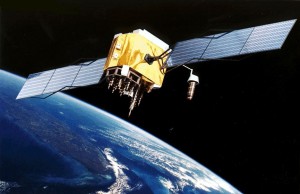 Since the beginning of time, man has looked for better ways to navigate. Land exploration was easier because of the various landmarks that prevailed, but oceanic exploration was an entirely different challenge. Early sailors created primitive charts of the coast lines and learned to look to the sun and stars for direction. Over time, man developed instruments such as the compass, quadrant, sextant and chronometers to assist sailors in charting their course. The first gyroscope compass that pointed true north was not invented until 1907. Radio detection and ranging (radar) was invented in 1935, and then long range navigation (Loran) was developed during World War II. But late in the 20th century, NAVSTAR, the official name for the global positioning system (GPS), was invented for military use. Between 1978 and 1994, the US Department of Defense launched 24 satellites into space. These satellites, which orbit about 12,000 miles above the earth and travel at 7,000 mph, complete two orbits every 24 hours. The satellites, each weighing about 2,000 pounds, are 17 feet wide and powered by solar panels. After about 10 years of service, a replacement satellite is launched into orbit to keep up the accuracy of the system. In the 1980s, the US government decided that the GPS system should also be available for civilian use. Today, GPS has become a necessity for all modes of transportation. When your GPS receiver is locked onto four or more satellites, it can determine latitude, longitude, altitude, speed, the time of sunrise and sunset and so much more. We are truly living in a fast-paced electronic era where a space-based global navigation system, maintained by our government with free accessibility to anyone with a GPS receiver, now provides us with the information we need for travel. And as fast as this new information age is emerging, it is a wonder to imagine what the next decade will bring.
Since the beginning of time, man has looked for better ways to navigate. Land exploration was easier because of the various landmarks that prevailed, but oceanic exploration was an entirely different challenge. Early sailors created primitive charts of the coast lines and learned to look to the sun and stars for direction. Over time, man developed instruments such as the compass, quadrant, sextant and chronometers to assist sailors in charting their course. The first gyroscope compass that pointed true north was not invented until 1907. Radio detection and ranging (radar) was invented in 1935, and then long range navigation (Loran) was developed during World War II. But late in the 20th century, NAVSTAR, the official name for the global positioning system (GPS), was invented for military use. Between 1978 and 1994, the US Department of Defense launched 24 satellites into space. These satellites, which orbit about 12,000 miles above the earth and travel at 7,000 mph, complete two orbits every 24 hours. The satellites, each weighing about 2,000 pounds, are 17 feet wide and powered by solar panels. After about 10 years of service, a replacement satellite is launched into orbit to keep up the accuracy of the system. In the 1980s, the US government decided that the GPS system should also be available for civilian use. Today, GPS has become a necessity for all modes of transportation. When your GPS receiver is locked onto four or more satellites, it can determine latitude, longitude, altitude, speed, the time of sunrise and sunset and so much more. We are truly living in a fast-paced electronic era where a space-based global navigation system, maintained by our government with free accessibility to anyone with a GPS receiver, now provides us with the information we need for travel. And as fast as this new information age is emerging, it is a wonder to imagine what the next decade will bring.
Previous ArticleHigh Roller
Next Article Unconventional
SharLeigh
SharLeigh has an inquisitive nature – she is interested in current events, history, science and many more subjects, including things that go bump in the night! Since 1997, SharLeigh has scoured the internet, looking for interesting, fun and timely topics covering all sorts of human-interest subjects for her articles from her home in Fontana, CA.
